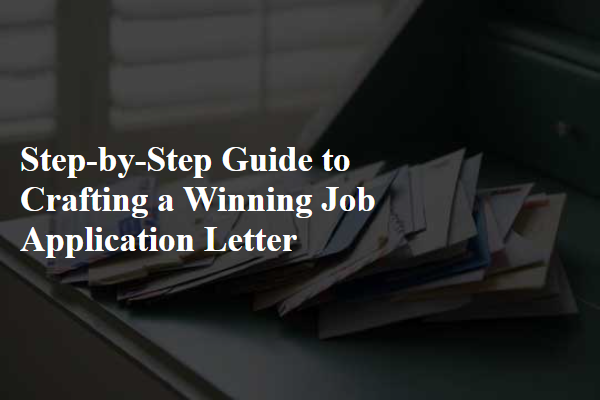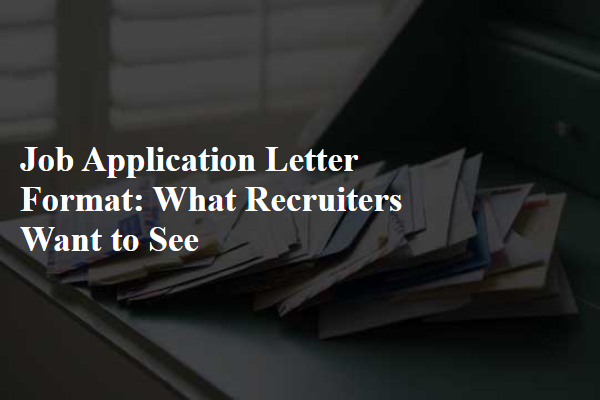
Begin by clearly stating the position you are applying for and where you found the job listing, ensuring your intent is immediately understood. Highlight your most relevant skills and experiences that align with the job requirements, demonstrating how you can add value to the company. Conclude with a confident closing, expressing enthusiasm for the opportunity and inviting further communication.
Understanding the Purpose of a Job Application Letter
How can you create an effective job application letter that stands out? Writing a clear and compelling job application letter is essential for catching the attention of hiring managers. Focus on showcasing your relevant skills, experiences, and enthusiasm for the role.
What are the key components of a successful job application letter? Include a personalized greeting, an introduction stating the job position, a highlight of your qualifications, and a strong closing paragraph expressing eagerness for an interview.
How do you tailor your job application letter to a specific company? Research the company's values, mission, and job description to align your skills and experiences with their needs. Use keywords from the job posting to pass automated screening systems.
What tone should you use in a job application letter? Maintain a professional and confident tone while reflecting your personality. Avoid overly casual language and ensure your writing is error-free and concise.
How important is formatting in a job application letter? Use a clean, easy-to-read font and standard business letter format. Keep paragraphs short and well-structured to enhance readability and create a positive impression.
Researching the Company and Job Role
Crafting a winning job application letter requires clear structure and targeted content. Follow these steps to create a compelling letter that captures employer attention.
- Research the Company - Understand the company's values and job requirements to tailor your letter effectively.
- Highlight Relevant Skills - Focus on your skills and experiences that align directly with the job description.
- Use Professional Language - Maintain a formal tone with concise and impactful wording to convey professionalism.
Analyzing the Job Description for Key Requirements
Crafting a winning job application letter requires clear communication of your skills and enthusiasm for the role. Understanding the employer's needs helps tailor your message effectively.
Start with a strong opening that captures attention and states the job you are applying for. Highlight relevant achievements and experiences that match the job description.
Use concise language to show how your qualifications align with the company's goals. Conclude with a confident call to action, expressing eagerness for an interview opportunity.
Proofread thoroughly to eliminate errors and ensure professionalism. A well-structured, personalized letter increases your chances of securing a job interview.
Structuring Your Application Letter Effectively
Crafting a winning job application letter involves clear and concise communication of your skills, qualifications, and enthusiasm for the role. Begin with a strong introduction stating the position you are applying for and a brief overview of your background. Highlight relevant achievements, customize the letter for the specific company, and conclude with a confident call to action to secure an interview opportunity.
Crafting a Strong Opening Statement
Crafting a winning job application letter requires clarity, relevance, and a professional tone. Tailoring your letter to the specific job and company increases your chances of catching the recruiter's attention.
Start by addressing the letter to the hiring manager using their name. Introduce yourself with a strong opening that highlights your enthusiasm for the position. Clearly match your skills and experiences with the job requirements, providing concise examples of your achievements.
Highlighting Relevant Skills and Experiences
Crafting a winning job application letter requires clear structure and focused content. This guide breaks down essential steps to create an impactful letter that captures employer attention.
- Research the Company - Gather detailed information about the company's values, mission, and job requirements to tailor your letter effectively.
- Customize the Opening - Address the hiring manager by name and mention the specific position to create a personalized introduction.
- Highlight Relevant Skills - Emphasize your experience and qualifications that directly match the job description to demonstrate suitability.
- Showcase Achievements - Include quantifiable accomplishments that illustrate your value and contributions in previous roles.
- Express Enthusiasm - Convey genuine interest in the company and role to build a positive connection with the reader.
- Include a Clear Call to Action - End with a request for an interview or further discussion to prompt employer engagement.
- Proofread Thoroughly - Eliminate spelling and grammar errors to ensure a professional and polished presentation.
Showcasing Achievements with Quantifiable Results
Crafting a winning job application letter requires clear structure, personalized content, and compelling language. Begin with a strong introduction highlighting your interest and relevant qualifications. Conclude with a confident call to action, encouraging further communication with the employer.
Demonstrating Cultural and Organizational Fit
Writing a job application letter is a crucial step in securing an interview and landing your desired position. A well-crafted letter highlights your skills, experience, and enthusiasm tailored to the job.
- Research the Company - Understand the company's values, mission, and job requirements to tailor your letter effectively.
- Structure Your Letter Properly - Use a clear introduction, body, and conclusion to organize your points logically and professionally.
- Showcase Relevant Skills - Highlight specific achievements and skills that match the job description to capture the employer's attention.
Following these steps increases your chances of making a strong impression and moving forward in the hiring process.
Polishing Language, Tone, and Formatting
Writing a strong job application letter is essential for making a positive first impression on potential employers. It highlights your skills, experience, and enthusiasm for the position, increasing your chances of landing an interview.
Start by researching the company and tailoring your letter to match the job description closely. Use clear, concise language to explain why you are the perfect fit for the role and how your background aligns with the company's goals.
Proofreading and Final Submission Tips
| Step | Description | Tips |
|---|---|---|
| 1. Research the Company | Gather detailed information about the company's mission, values, culture, and recent achievements to tailor your letter effectively. | Visit company website, social media, and review employee testimonials. |
| 2. Address the Recipient Properly | Identify the hiring manager's name or use a professional greeting to create a personalized and respectful introduction. | Use "Dear [Name]" or "Dear Hiring Manager" if name is unavailable. |
| 3. Write a Strong Opening | Capture attention by stating the position you are applying for and briefly highlighting your enthusiasm and qualifications. | Include job title and a compelling reason for your interest. |
| 4. Showcase Relevant Skills and Experience | Link your qualifications directly to the job requirements using specific examples and accomplishments. | Quantify achievements and use keywords from the job posting. |
| 5. Explain Why You Fit the Company | Demonstrate how your values and goals align with the company's culture and objectives. | Reference company goals, culture, and how you will contribute. |
| 6. End with a Strong Closing | Express your eagerness for an interview and provide your contact information for follow-up. | Use polite, confident language such as "I look forward to discussing my qualifications." |
| 7. Proofread and Edit | Check for spelling, grammar, and formatting errors to ensure a polished and professional letter. | Read aloud, use grammar tools, and ask a trusted person to review. |



Comments